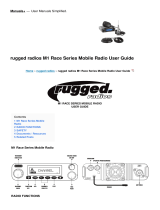
PART 15 COMPLIANCE
This device complies with Part 15 of the FCC Rules. Operation is subject to the following two conditions: (1) this device does not cause harmful interference, and
(2) this radio must accept any interference that may cause undesired operation.
Exposure To Radio Frequency Energy Your Rugged radio is designed to comply with the following national and international standards and guidelines regarding
exposure of human beings to radio frequency electromagnetic energy.
• United States Federal Communications Commission, Code of Federal Regulations: 47 CFR part 2 sub-part J
• American National Standards Institute (ANSI)/Institute of Electrical & Electronics Engineers (IEEE) C95. 1-1992
• Institute of Electrical and Electronics Engineers (IEEE) C95. 1-1999 Edition
• National Council on Radiation Protection and Measurements (NCRP) of the United States, Report 86, 1986
• International Commission on Non-lonizing Radiation Protection (ICNIRP) 1998
• To control your exposure and ensure compliance with the general population or uncontrolled environment exposure limits, transmit no more than 50% of the
time. The radio generates measurable RF energy exposure only when transmitting.
Important: Changes or modifications to this unit not expressly approved by Rugged Radios could void your right to operate this unit. Your radio is set up to
transmit a regulated signal on an assigned frequency. It is against the law to alter or adjust the settings inside the COMMUNICATOR to exceed those limitations.
Any adjustment to your radio must be made by qualified technicians.
SAFETY
This radio generates RF electromagnetic energy during transmit mode. This radio is designed for and classified as “Occupational Use Only,” meaning it must be
used only during the course of employment by individuals aware of the hazards, and the ways to minimize such hazards. This radio is NOT intended for use by the
“General Population” in an uncontrolled environment. This radio has been tested and complies with the FCC RF exposure limits for “Occupational Use Only”. In
addition, this radio complies with the following Standards and Guidelines with regard to RF energy and electromagnetic energy levels and evaluation of such levels
for exposure to humans: FCC OET Bulletin 65 Edition 97-01 Supplement C, Evaluating Compliance with FCC Guidelines for Human Exposure to Radio Frequency
Electromagnetic Acids. American National Standards Institute (C95.1-1992), IEEE Standard for Safety Levels with Respect to Human Exposure to Radio
Frequency Electromagnetic Fields, 3 kHz to 300 GHz. American National Standards Institute (C95.3-1992), IEEE Recommended Practice for the Measurement
of Potentially Hazardous Electromagnetic Fields— RF and Microwave. The following accessories are authorized for use with this product. use of accessories other
than those (listed in the instruction) specified may result in RE exposure levels exceed the FCC requirements for wireless RE exposure.
To ensure that your exposuree to RF electromagnetic energy is within the FCC allowable limits for occupational use, always adhere to the following guidelines:
DO NOT operate the radio without a proper antenna attached, as this may damage the radio and may also cause you to exceed FCC RF exposure limits. A
proper antenna is the antenna supplied with this radio by the manufacturer or antenna specifically authorized by the manufacturer for use with this radio. DO
NOT transmit for more than 50% of total radio use time. Transmitting more than 50% of the time can cause FCC RF exposure compliance requirements to
be exceeded. The radio is transmitting when the ‘TX indicator’ lights up red. You can cause the radio to transmit by pressing the PTT switch. ALWAYS keep the
antenna at least 2.5 cm (1 inch) away from the body when transmitting and only use the provided belt-clip to ensure FCC RF exposure compliance requirements
are not exceeded. To provide the recipients of your transmission the best sound quality, hold the antenna at least 5 cm (2 inches) from your mouth, and slightly
off to one side. The information outlined in this manual provides the user with the information needed to make him or her aware of RF exposure and what to do in
order to assure this radio is operated safely within the FCC exposure limits.
ELECTROMAGNETIC INTERFERENCE/COMPATIBILITY DURING TRANSMISSION
Your radio generates RF energy that can possibly cause interference with other devices or systems. To avoid such interference, turn off the radio inareas where
signs are posted to do so. DO NOT operate the transmitter in areas that are sensitive to electromagnetic radiation such as hospitals, aircraft, and blasting sites.
GMR45 MOBILE RADIO USER GUIDE | VERSION 1.3.0 | AUG 2022


